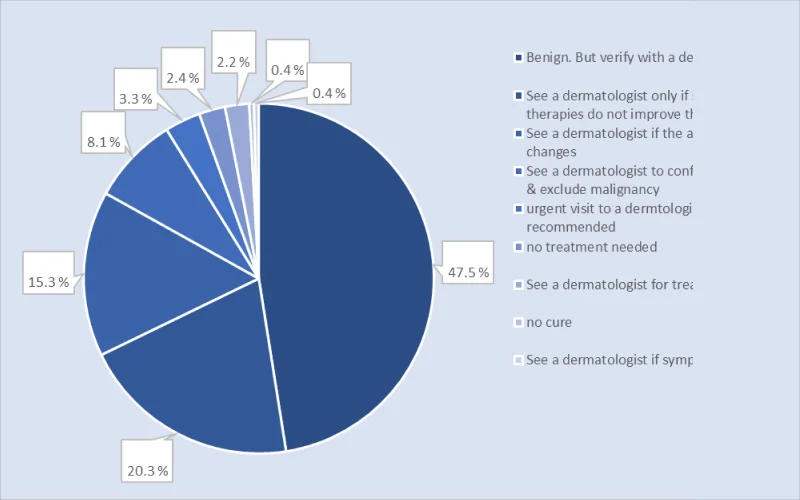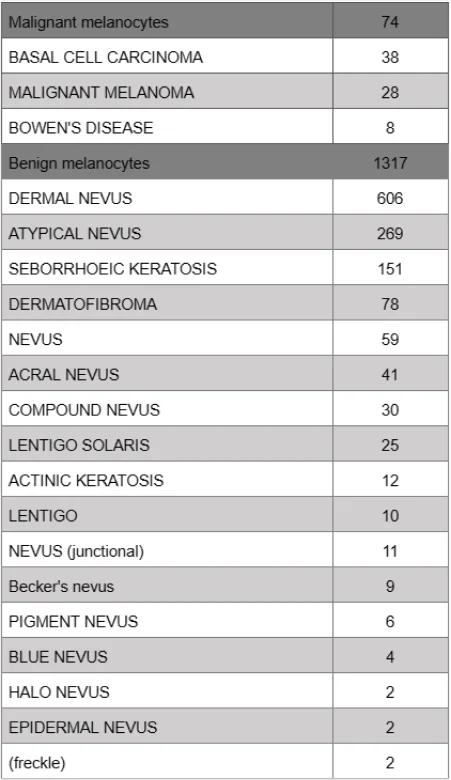Charles SLBG Foundation Skin Cancer Screening Report
Main Author: Madushi Jayawickrama | Faculty of Medicine, University of Ruhuna
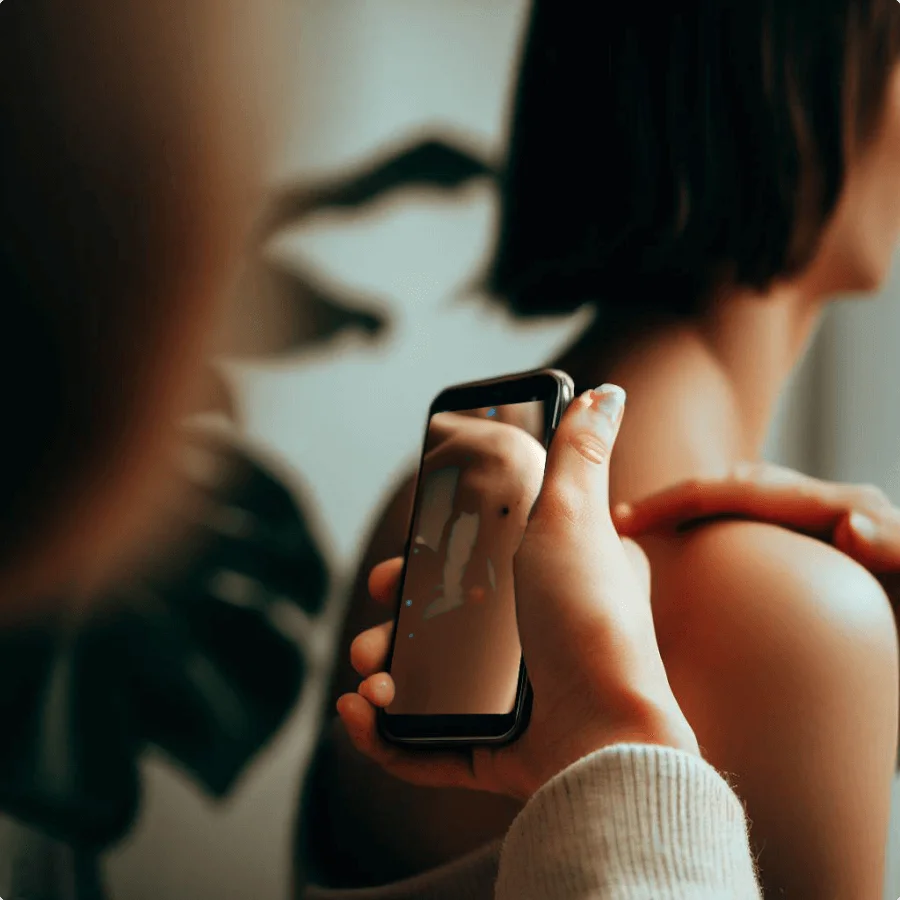
Introduction
The online skin cancer screening project launched by First Derm and The Charles SLBG Foundation aims to provide a free assessment service and help catch skin cancer lesions early, especially in young people. This service is free, fast, and confidential. Users are advised to see a dermatologist when necessary; for others, reassurance is provided and unnecessary doctor visits are prevented.
This literature review is intended to summarize current trends in utilizing teledermatology for skin cancer screening and to highlight the requirement and importance of the First Derm Free Online Skin Cancer Screening Project specifically.
Skin cancers can be identified at early stages because of the outward manifestation of a visible skin lesion. Research evidence shows that the most common type of cancer seen in the United Kingdom is Keratinocyte Cancer (KC), which includes the two main non-melanoma skin malignancies: basal cell carcinoma and cutaneous squamous cell carcinoma.1 One in every five people in the United Kingdom has had non-melanocytic skin cancer at some point in their lives.1 Therefore, the identification and treatment of skin malignancies are essential. Also, according to national cancer registration data analysis, the mortality rate due to melanoma in the United Kingdom is increasing.2 This may depict increasing incidence with simultaneous stable survival of the patients, therefore it implies a recent improvement in survival/prognosis. 2
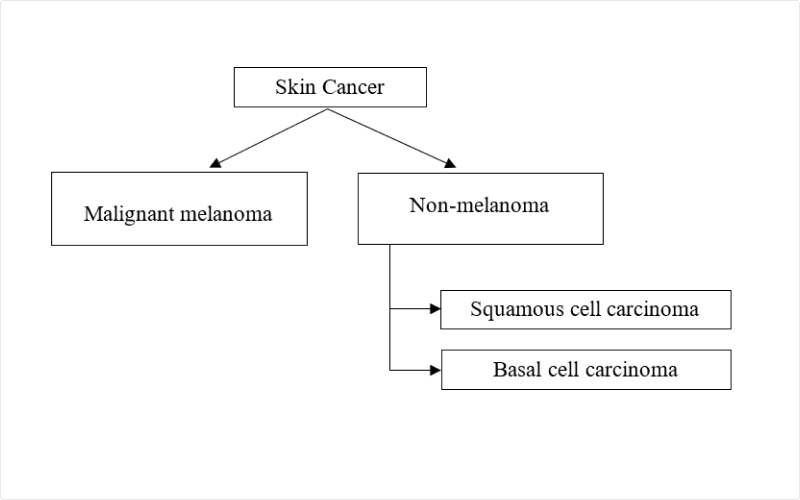
Figure 1: Classification of skin cancer
Methods
A literature search was conducted through PubMed with the aim of identifying patterns and current trends in online skin cancer screening platforms. Table 1 summarizes the search terms used, and the number of results that were obtained.
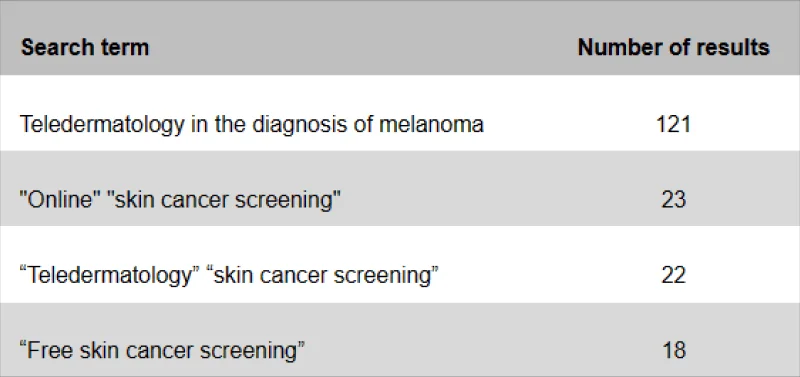
Table 1: Summary of PubMed search results
As shown in Figure 2, the usage of teledermatology tools for the diagnosis of melanoma has increased progressively from 2012 to 2021. The survival/prognosis improvement may correlate to the increased usage of online platforms for skin cancer screening, which helps in early diagnosis.

Figure 2: Usage of Teledermatology tools for the diagnosis of melanoma
Similar platforms
Several existing initiatives provide skin cancer screening services free of charge, including “Melanoma Monday” and “Euro Melanoma Monday”. Melanoma Monday, initiated in 1985 by the American Academy of Dermatology (AAD) has provided free screening for more than 2.1 million individuals and identified 23 500 suspected melanomas to date.3 These screening days are in the month of May and also increase public awareness of skin cancers, which helps in directing patients to dermatologists for early diagnosis. However, in these physical screening projects, accessibility is not dispersed equally to everyone.
Teledermatology has taken an increasingly prominent role in the health care system as it gained the interest of the scientific community in recent years.4 Its potential to revolutionize the delivery of dermatology services has been depicted in several studies. Especially the efficacy of teledermatology as a triage system is highlighted.4
There have been a number of teledermatology applications tested in skin cancer screening. The majority of these platforms used the submission of images of the lesions for visual examination, which were compared with a virtual database. Several studies have been conducted to compare the outcomes of face-to-face diagnosis and diagnosis made using teledermatology. Tan et al. present promising results with only a 12.3% disparity between the outcomes of the two modes used.5 Massone et al. show similar results in the study conducted to assess the feasibility of teledermatology using mobile phone photographs of pigmented skin lesions.6 89% accuracy is reported in teleconsulting. However, only 18 patients were involved in this latter study.
An observational cross-sectional study conducted by the Center for Telemedicine and Telehealth of State Secretariat of Health of Santa Catarina to compare the diagnosis of skin cancer in teledermatology and primary care reports low compatibility between the two.7 And according to the current literature, the number of online skin cancer screening platforms that are freely accessible is extremely low. Börve el al proved that teledermoscopy was an excellent way of referring the right patient at the right time from primary care to a dermatology center, saving time, money and patient burden of coming back for a second visit8. They identified 35 malignant melanomas; instead of waiting an average 35 days to come in with a melanoma using the traditional referral system, all suspected melanoma patients were seen within 9 days and 84% had surgery on the first visit. In the study they also showed that the depth of malignant melanoma (Breslow score) was considerably thinner compared to the traditional referrals, 1mm vs 2mm, which is considerable considering the survival rate.
First Derm platform
First Derm offers online dermatology and has been created from scientific research8 and is available as an app or via the web. In regards to this SLBG foundation project, it has been offered for free, mainly targeting young people living in the United Kingdom. Through the First Derm website, the users can submit a close-up photograph (10 cm/ 4 inches away) and an overview photograph (30 cm/ 12 inches away) of the lesion. Then they are allowed to describe the lesion in detail, with information such as location, color, size, and duration of it. Finally, the other details such as gender, age, and country. Based on these details, a probable diagnosis and guidance for management and treatment are provided to the patient within 24 hours. Patients can either view the reply through the website, app, or email. Privacy and confidentiality are assured for all users.
Unlike fully automated systems where the submitted data is analyzed by an algorithm that has been trained on a database, the First Derm platform involves a panel of board-certified dermatologists who will provide their expert opinions after assessing the data and images of the submitted skin lesions. Therefore, it is safe and reliable. This online platform makes healthcare more accessible worldwide because anyone with internet access and a smartphone can use this service. It provides people the opportunity to connect with experts from the comfort of their own homes. This platform provides solutions for unequally distributed medical experts in different geographical areas and economic burdens that are restricting the efficacy of the conventional face-to-face screening system.
Furthermore, it has an extremely user-friendly interface with clear instructions. People can access the landing page through the First Derm website. In addition to skin cancer screening, this platform offers patient education regarding various skin pathologies through the First Derm website. Multiple images and relevant details explained in a simple understandable manner helps the general public improve their knowledge of the conditions they might have.
Acquiring users
We used Google ads targeted to UK users for $2333 during the six months period. Targeting 25 to 65 years old and both genders. With a broad set of keywords all regarding checking your moles for free.

Distribution of campaign reach within the age group 25 – 64
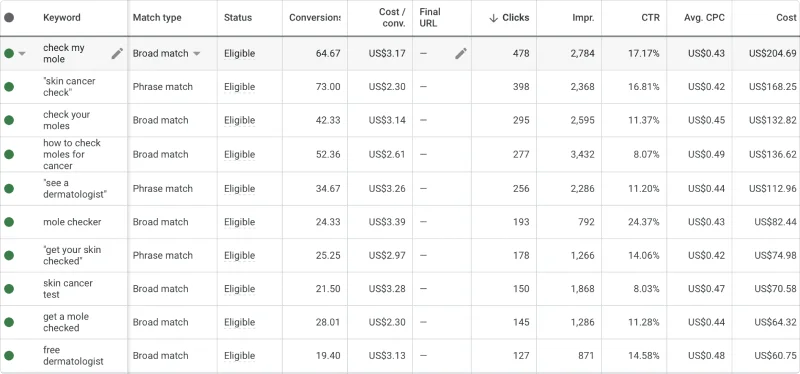
Keywords used in the Google ads campaign

Ad spent within 6 months period
Screening results
-
- Aggregate data
- Usage of First derm free skin cancer screening platform by different age groups
- Gender analysis of clients of First Derm free skin cancer screening platform
- Skin malignancies and the 10 most common skin conditions identified
- Differential count of identified skin malignancies
- Recommendations given
- Skin conditions with malignant melanocytes and benign melanocytes
- Overall trends
- Limitations in data review
Aggregate data
- A total of 2071 responses were received during 6 months: From June 2022 to November 2022.
- Cases/day: 11.32
- Number of different conditions identified: 83
Usage of the First Derm free skin cancer screening platform by different age groups
- The average age of users: 29 years old
- Youngest user: 4 years old
- Oldest user: 66 years old
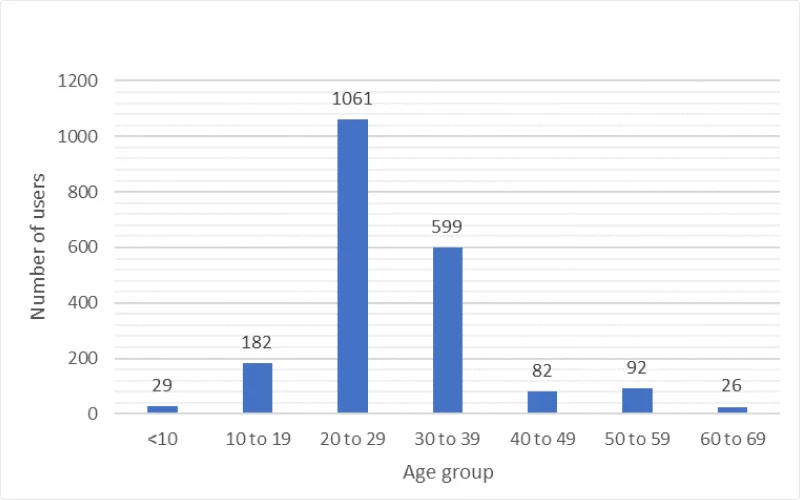
Usage of First Derm skin cancer screening platform by different age groups
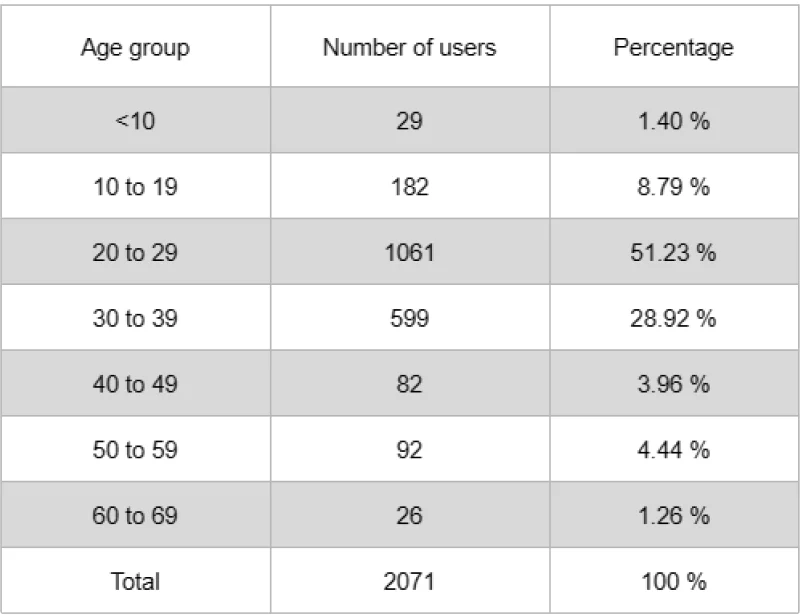
First Derm skin cancer screening platform usage by age groups, respective no of users, and their percentage
Gender analysis of clients of the First Derm free skin cancer screening platform
- The majority of users were females.
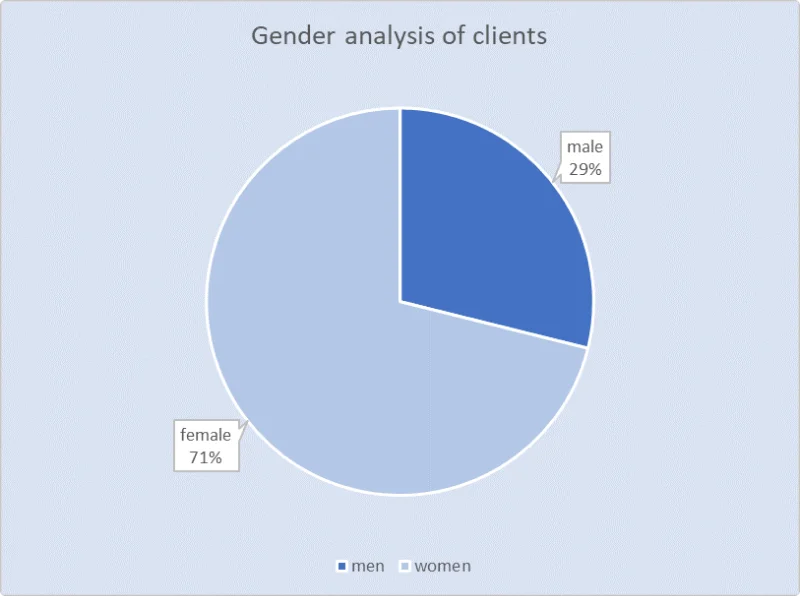
A pie chart showing the gender distribution of First Derm’s skin cancer screening users
Skin malignancies and the 10 most common skin conditions identified
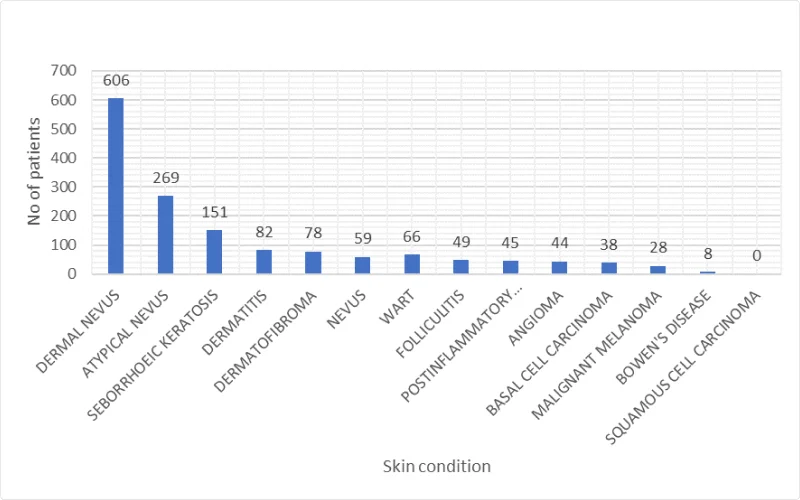
Skin malignancies and the 10 most common skin conditions identified
Differential count of identified skin malignancies
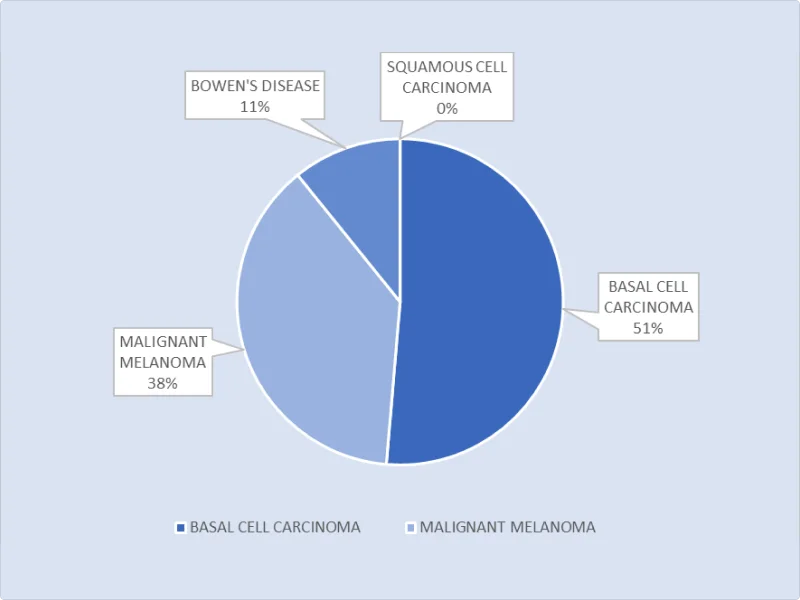
Differential count of identified skin malignancies
Recommendations given
- Potentially 28 lives were saved (malignant melanomas).
- 802 unnecessary consultations were prevented.
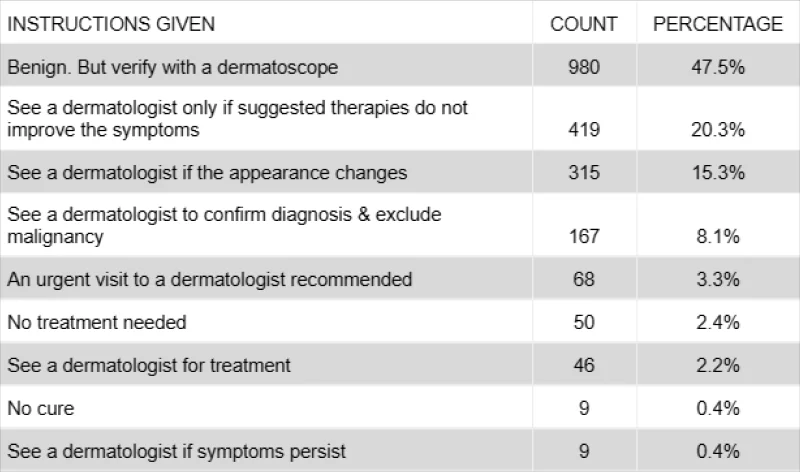
Table showing the instructions given during the online skin cancer screening via first derm and their corresponding count and percentage
Skin conditions with malignant melanocytes and benign melanocytes

Skin conditions with malignant melanocytes and benign melanocytes
Overall trends
- 802 unnecessary consultations were prevented.
- Users of the First Derm Free Online Skin Cancer Screening platform are typically males in their late 20s from the UK.
- This platform has had the potential to save lives, because of the early detection of malignant melanoma.
Limitations in data review
Unclear images and some other problems lead to the inability to arrive at a certain answer on the skin concern, in which case multiple differential answers were listed.
Conclusion
According to the literature, skin malignancies are a major ongoing problem with high prevalence, high mortality, and morbidity rates. Early diagnosis is extremely important for a favorable prognosis. Therefore new methods are necessary for early diagnosis and to direct patients with suspicious skin lesions to dermatologists fast.
The First Derm online skin cancer screening platform fulfills these requirements and identified 28 potential malignant melanomas. Eighty percent of the users were between 20-39 years old. As a triage tool for the early detection of skin cancers, this platform has great value. The literature contains both successful and unsuccessful attempts at utilizing teledermatology as a diagnostic and screening tool.
References
- Kwiatkowska, M., Ahmed, S., Ardern-Jones, M., Bhatti, L. A., Bleiker, T. O., Gavin, A., Hussain, S., Huws, D. W., Irvine, L., Langan, S. M., Millington, G. W. M., Mitchell, H., Murphy, R., Paley, L., Proby, C. M., Thomson, C. S., Thomas, R., Turner, C., Vernon, S., & Venables, Z. C. (2021). An updated report on the incidence and epidemiological trends of keratinocyte cancers in the United Kingdom 2013–2018. Skin Health and Disease, 1(4). https://doi.org/10.1002/SKI2.61
- Memon, A., Bannister, P., Rogers, I., Sundin, J., Al-Ayadhy, B., James, P. W., & McNally, R. J. Q. (2021). Changing epidemiology and age-specific incidence of cutaneous malignant melanoma in England: An analysis of the national cancer registration data by age, gender, and anatomical site, 1981–2018. The Lancet Regional Health – Europe, 2. https://doi.org/10.1016/J.LANEPE.2021.100024
- Boulos, S., Fiala, K., & Butler, D. F. (2012). Free skin cancer screening provides access to care. Journal of the American Academy of Dermatology, 67(4), 787–788. https://doi.org/10.1016/J.JAAD.2012.02.027
- Fabbrocini, G., de Vita, V., Pastore, F., D’Arco, V., Mazzella, C., Annunziata, M. C., Cacciapuoti, S., Mauriello, M. C., & Monfrecola, A. (2011). Teledermatology: from prevention to diagnosis of nonmelanoma and melanoma skin cancer. International Journal of Telemedicine and Applications, 2011. https://doi.org/10.1155/2011/125762
- E. Tan, A. Yung, M. Jameson, A. Oakley, and M. Rademaker,“Successful triage of patients referred to a skin lesion clinicusing teledermoscopy (IMAGE IT trial),”British Journal ofDermatology, vol. 162, no. 4, pp. 803–811, 2010.
- C. Massone, R. Hofmann-Wellenhof, V. Ahlgrimm-Siess, G.Gabler, C. Ebner, and H. P. Soyer, “Melanoma screening with cellular phones,”PloS one, vol. 2, no. 5, p. e483, 2007.
- Piccoli, M. F., Amorim, B. D. B., Wagner, H. M., & Nunes, D. H. (2015). Teledermatology protocol for screening of skin cancer. Anais Brasileiros de Dermatologia, 90(2), 202–210. https://doi.org/10.1590/ABD1806-4841.20153
- Börve A, Dahlén Gyllencreutz J, Terstappen K, Johansson Backman E, Aldenbratt A, Danielsson M, Gillstedt M, Sandberg C, Paoli J. “Smartphone Teledermoscopy Referrals: A Novel Process for Improved Triage of Skin Cancer Patients.” Acta Derm Venereol (2014). Web.

The Specialist doctor from the University Hospital in Gothenburg, alumnus UC Berkeley. My doctoral dissertation is about Digital Health and I have published 5 scientific articles in teledermatology and artificial intelligence and others.

